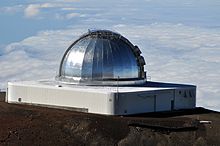Infrared Telescope Facility
 |
|
| Location(s) |
Mauna Kea |
|---|---|
| Coordinates | 19°49′35″N 155°28′23″W / 19.8263°N 155.473°WCoordinates: 19°49′35″N 155°28′23″W / 19.8263°N 155.473°W |
| Telescope style |
infrared telescope, Cassegrain reflector |
| Website | irtfweb |
|
|
|
|
[]
|
|
The NASA Infrared Telescope Facility (NASA IRTF) is a 3-meter (9.8 ft) telescope optimized for use in infrared astronomy and located at the Mauna Kea Observatory in Hawaii. It was first built to support the Voyager missions and is now the USA national facility for infrared astronomy, providing continued support to planetary, solar neighborhood, and deep space applications. The IRTF is operated by the University of Hawaii under a cooperative agreement with NASA. According to the IRTF's time allocation rules, at least 50% of the observing time is devoted to planetary science.
The IRTF is a 3.0 m (118" effective aperture) classical Cassegrain telescope. The Cassegrain focus f/ratio is f/38 and the primary mirror f/ratio is 2.5. Several aspects of the design of IRTF are optimized for IR observations. The secondary mirror is undersized to prevent the instrument from seeing the thermal emission from the telescope structure around the primary mirror. The primary mirror itself is 126" in diameter, but only the center 118" is used. A small mirror in the center of the secondary mirror prevents the instrument from seeing its own thermal emission. The f/ratio is long to have a small secondary mirror, again to minimize the telescope's thermal emission. The mirror coatings are chosen to have minimal thermal emission. The emissivity of the telescope is usually below 4%. The secondary mirror is mounted on a chopping mechanism to rapidly switch the pointing of the telescope from target to sky at up to 4 Hz.
The IRTF is mounted on a large English yoke equatorial mount. The mount is very stiff, reducing flexure and allowing for accurate pointing of the telescope. Since the telescope is on an equatorial mount, the telescope can observe targets through the zenith without concern for field rotation. The yoke mount prevents the telescope from pointing north of +69 degrees declination. Since the telescope was primarily intended for planetary science, this restriction was considered to be acceptable. Since the telescope is on a heavy mounting, it is relatively immune from vibration or wind shake.
The IRTF hosts 4 facility instruments: SpeX, NSFCam2, CSHELL, and MIRSI. MORIS is currently being tested. IRTF also hosts a number of visiting instruments.
SpeX is a medium-resolution 0.8-5.4 µm spectrograph built at the Institute for Astronomy (IfA), for the NASA Infrared Telescope Facility (IRTF) on Mauna Kea. The primary scientific driver of SpeX was to provide maximum simultaneous wavelength coverage at a spectral resolving power which is well-matched to many planetary, stellar and galactic features, and at resolving power which adequately separates sky emission lines and disperses sky continuum. This requirement has resulted in an instrument which provides spectral resolutions of R~1000-2000 across 0.8-2.4 µm, 2.0-4.1 µm, and 2.3-5.5 µm, using prism cross-dispersers (15 arcsec-long slits). Single order long slit (60 arcsec) modes are also availavble. A high throughput prism mode is a provided for 0.8-2.5 µm spectroscopy at R~100 for solid state features and SEDs. A Raytheon Aladdin 3 1024x1024 InSb array is used in the spectrograph. SpeX also contains an infrared slit-viewer/guider covering a 60x60arcsec field-of-view at 0.12arcsec/pixel. A Raytheon Aladdin 2 512x512 InSb array in the infrared slit-viewer. The infrared slit viewer can also be used for imaging or photometry. SpeX is used for a wide array of planetary and astrophysical research programs, and is the most requested instrument on IRTF. SpeX will be taken off of the telescope for about 6 months to upgrade its arrays starting in August 2012.
...
Wikipedia
